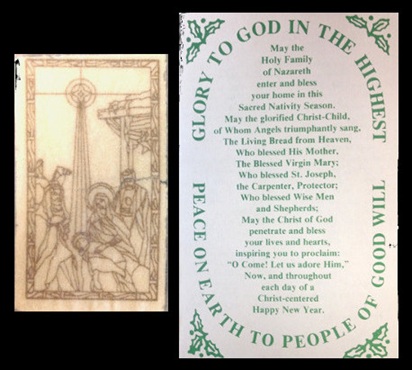University Libraries
An Edible Archive at the Marian Library
As an archive assistant at the Marian Library, I spend quite a bit of time sorting through our expansive collection of all things Mary. The collection contains the obvious, holy cards, but also includes anything from postcards, stamps, and bookmarks to Marian candy brought back from Lourdes. Needless to say, I come across some unique finds during my time in the Marian Library.
On one occasion, as I was sorting through a box of holy cards, I came across one such novelty. As I leafed through a section of Nativity holy cards, one in particular caught my eye. As I carefully removed it from its protective leaflet to inspect it further, I quickly realized it wasn’t paper. I could feel the fragile material starting to crack, and I immediately slid it back into its envelope. To my amazement, after reading over the pamphlet that came with it, I discovered that this was no holy card. It was bread. It was, in fact, a Christmas Wafer made in 1992 from the Christmas Wafer Bakery in Lewiston, New York. The fragile wafer, made of the same type of unleavened bread that Jesus blessed and gave to his disciples at the Last Supper, features a decorative image of the Nativity scene that includes the Holy Family and the Magi, as well as the star and the stable.
Incidentally, the Christmas Oblation Wafer is a Catholic tradition that spans the centuries. As tradition has it, families customarily gather to break and share the Christmas wafer on Christmas Eve as a sign of unity and reverence. After a quick Google search, I found that the Christmas Wafer is particularly popular in Poland and other Eastern European countries, where the wafer is known as the oplatek. Before dinner on Christmas Eve, each member of the family breaks off a piece of the oplatek and passes it, along with good wishes, to the next person. This sequence of breaking and sharing typically progresses from the oldest member of the family to the youngest, and is essentially an expression of the family’s love and care for one another (Food for Thought, 2012). This sweet Christmas tradition is new to me, but I’m sure the many families that have carried on this legacy for years couldn’t imagine a Christmas Eve without it.
What I thought was a regular holy card actually turned out to be an edible archive with a rich heritage. I can never be sure what unique item I’ll come across next in the Marian Library. Come up to the seventh floor of Roesch and check out our collections for yourself. You’ll be surprised what you might find!
-Megan Burian '16, Marian Library Archive Assistant


